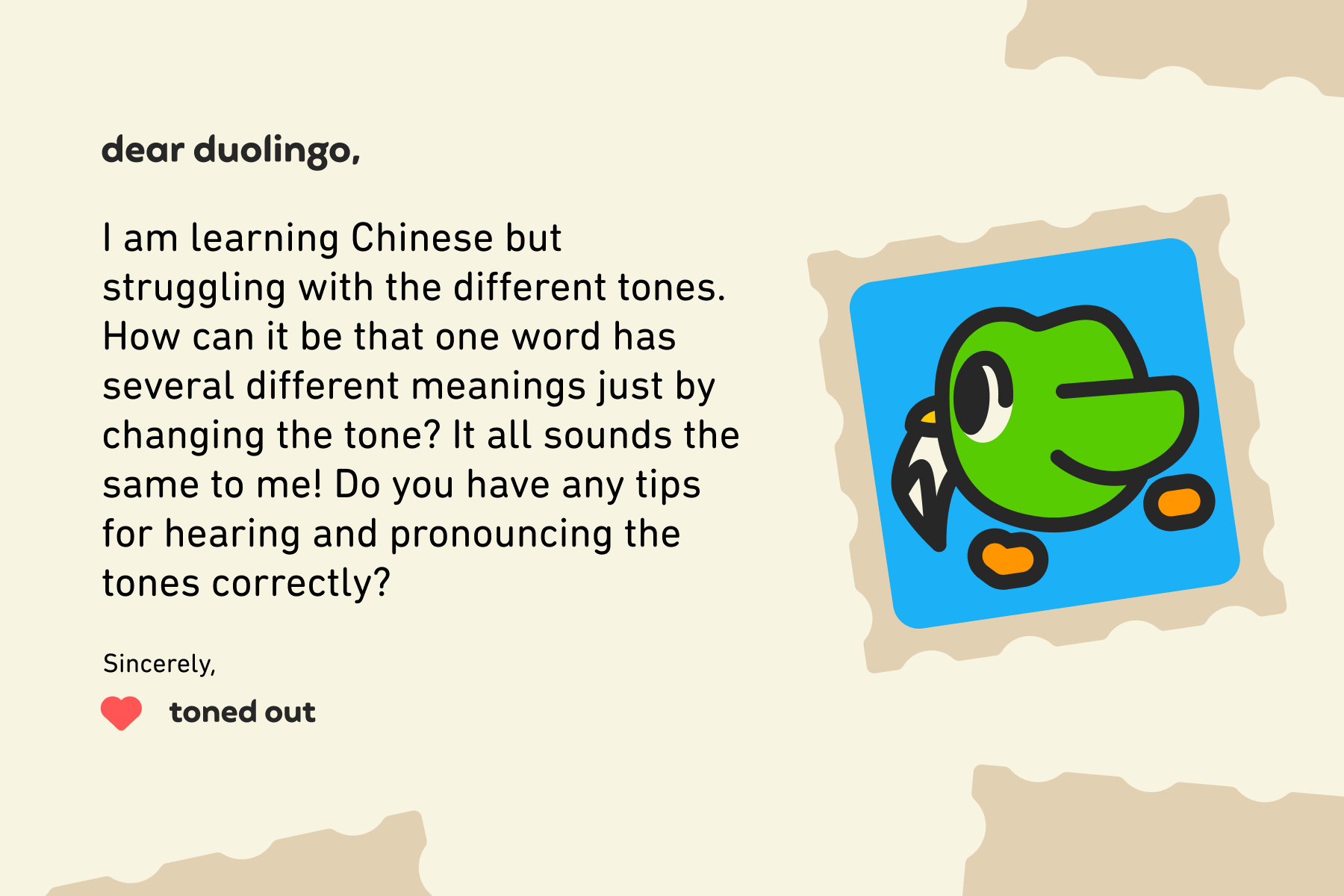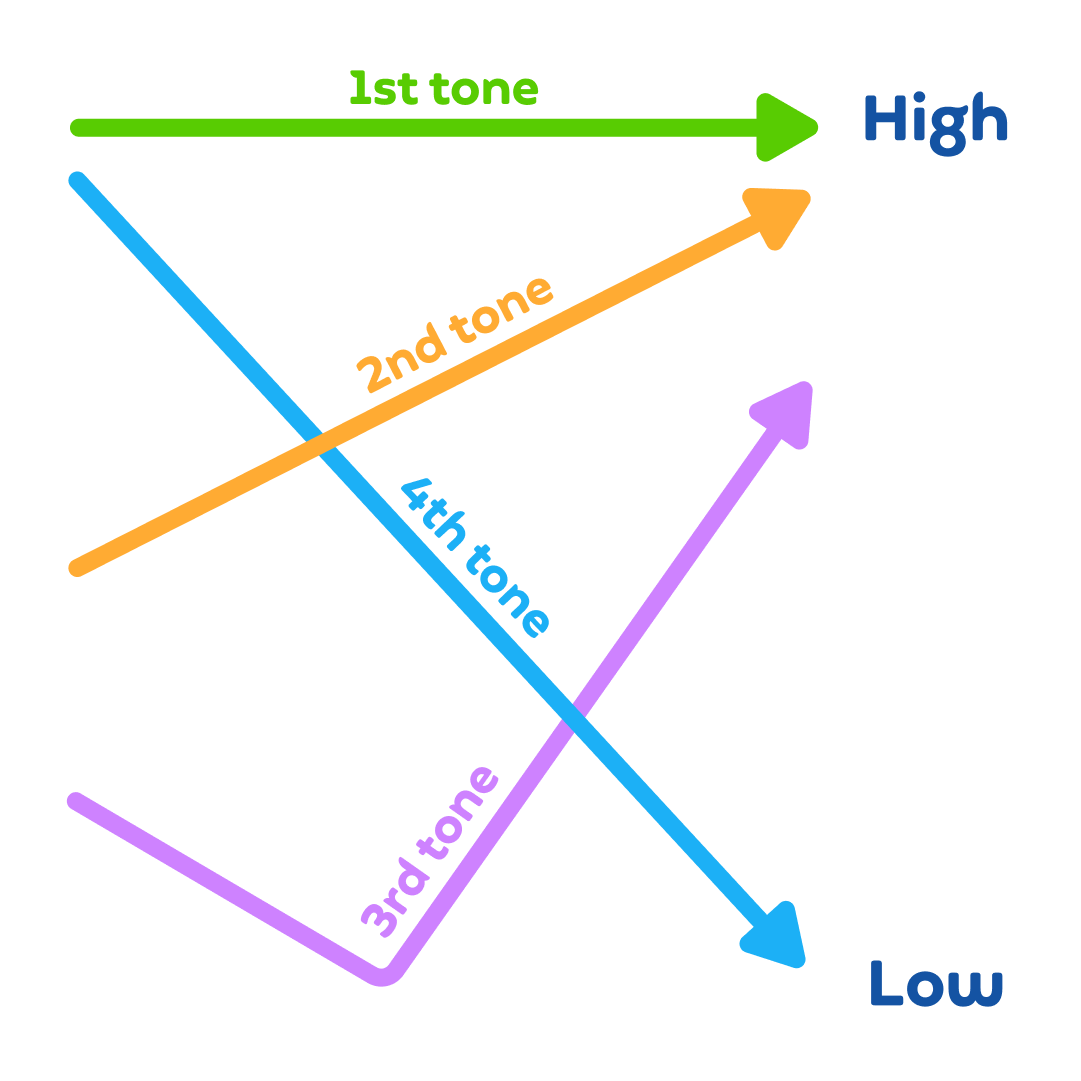Welcome to another week of Dear Duolingo, an advice column just for language learners. Catch up on past installments here.
Hey there! I’m Dr. Farrah Neumann, a Duolingo Learning Scientist, and I’m leading Dear Duolingo this week! To answer today’s question, I’m joined by Curriculum Designers Tina Tan and Dr. Adele Touhey. My background is in second language acquisition and speech sound learning, and at Duolingo I apply language-learning research to new products and features in the app. Tina and Adele create new courses and content in the app; right now, Tina is working on the English course for Vietnamese speakers, and Adele is focused on the English course for Russian speakers. They both have backgrounds in teaching English and Chinese—and that’s why we’re taking over Dear Duolingo this week! We’re pulling together our powers as language teachers, learners, and researchers to bring you an all-star guide to learning tones in Mandarin Chinese!
Here’s this week’s question:

Don’t worry, Toned Out, it makes complete sense that you are feeling challenged by Chinese tones. Any aspect of a language that’s different from your first language can take some getting used to! Tone is absolutely within your grasp—check out the success stories of Xiaomanyc and OMG! Meiyu for inspiration! There are lots of strategies for practicing (and one day mastering!) tones in Mandarin Chinese.
Let’s dig into what tones really are and strategies for learning them.
What are Chinese tones?
Chinese is a tonal language. (This is true of both Mandarin and Cantonese—but we’ll focus just on Mandarin today.) Tones are patterns of your voice going up and down (called “pitch”), so a tone (and your voice!) can be high (think violin) or low (think tuba). Tones may make learners of Chinese shake in their boots, but they serve a really important function for Chinese speakers! In languages that have them, tones help you know what word and meaning is meant. They are just as important as individual sounds, like “m” or “a,” and using a different tone can totally change the meaning of words! In a tonal language, each tone has a unique pattern of how to change your voice when you pronounce the sounds.
The good news is that as English speakers, we often hear and pronounce those voice movements, even if we’ve never used the words “pitch” or “tone.” For example, we often make our voice go up at the end of questions, to show that we’re asking something. The difference is that in English, making our voice go up or down, higher or lower, doesn’t change the meaning of a word: cats always means the same thing no matter if our voice goes up (“…Cats?”), stays flat (“Cats.”), or does anything else (“CATS!!!”). So for English speakers learning a tonal language like Chinese, we just have to work a little harder to learn to use the pitch of our voice in a new way: changing our voice for each syllable!
Learning Mandarin Chinese tones
To say that the tones are extremely important would be an understatement! Every Chinese word has tone! The four tones in Mandarin Chinese are steady, rising, falling-rising, and falling. Those names tell you a lot about how each is pronounced!
- Steady: Keep your voice high and steady, without raising or lowering it
- Rising: Make your voice go up
- Falling-rising: Make your voice start low, go lower and then up
- Falling: Make your voice go down
Beginner Chinese learners will find Pinyin (a Romanized way of writing Chinese) really helpful in learning tones, because this writing system has a distinct symbol for each tone. You can see them in the words mā, má, mǎ, and mà and they sort of mimic what your voice has to do when you say them! Those four different tones create four totally different words with four totally different meanings: mother, hemp, horse, and scold, to be exact! So you can see why getting these tones right matters. You wouldn’t want to accidentally call your mother a horse (I presume). Switching the tone from mā (steady tone) to má (rising tone) changes the meaning of the word as much as switching the “w” in witch to something else (pitch, ditch, you get the idea!). Tones are powerful building blocks of words, as much as vowels and consonants—they totally change the meaning of words!
These four Chinese tones are numbered, but the numbers don’t refer to any inherent order, they’re just a way to know which tone people are referring to. In the table below, you’ll see each of these tones, how your voice and pitch move, and how to write it with a tone mark. Take a look at how each tone completely changes the meaning of the word!
| Tone | Tone mark | How the tone sounds | Your visual reminder |
|---|---|---|---|
| 1. Steady | 妈 mā (mother) |
Tone 1 is high pitched and steady. Imagine your doctor has told you to open your mouth and say “ahhhh,” and then hold that pitch steady! |  |
| 2. Rising | 麻 má (hemp) |
Tone 2 starts low and rises high at the end. Imagine you are saying “What?!?” after your friend shares some juicy gossip. |  |
| 3. Falling-Rising | 马 mǎ (horse) |
Tone 3 starts low, dips lower, and then rises up a little bit. It sounds similar to the way you would say “Well…” if your friend asks if you have a new love interest and the answer is yes (!). |  |
| 4. Falling | 骂 mà (scold) | Tone 4 starts high and falls to end low. It has a similar pitch as a forceful “No!” |  |
This Chinese tones chart is another useful way to remember these four tones. You can really see how tone pronunciation varies in two different ways: 1) how high or low your voice is (is the tone high and towards the top of the chart, or low and towards the bottom of the chart?), and 2) how your voice moves (steady, rising, falling-rising, falling).

Why does Chinese have tones?
Languages around the world vary in the number and kinds of sounds they have, and whether they have tones! Chinese has fewer consonants and vowels than English does (for example, there is no “v” sound in Chinese), so there are fewer ways to combine sounds into unique words. That’s where tones come in! Tone allows Chinese to more than quadruple the number of words that speakers can make using the same number of vowels and consonants.
Chinese isn’t the only language that uses tones, either! A large number of sub-Saharan African, Asian, and indigenous American languages do as well. And the number of tones in a language can vary—it’s not unusual for a tone language to have 5-6 tones, and Wobé, spoken on the Ivory Coast of Africa, may have as many as 14!
How can I practice Chinese tones?
Now that you’ve got a solid understanding of what tone is and why it’s so important, here’s how you can practice hearing and pronouncing tones!
Listening: Research shows that learning to better hear sounds will make you better able to pronounce them, too. So start by tuning your ear to the differences between the tones!
- Complete your daily Duolingo lessons to keep training your ear. Duolingo uses many different speakers, words, and contexts, which is extremely effective at helping you learn sounds and tones in your new language!
- While you do your lessons, keep a log of the new words you are learning, and note the tones of each word using the Pinyin symbols (e.g. ā, á, ā, à).
- Listen to many examples of tone. As you do your Chinese lessons in Duolingo, tap on the speaker icon to replay and relisten to words and sentences to identify which tones you hear. Then check your guess against the Pinyin in the lesson. You can make this a sort of game for yourself! This handy Pinyin table is also a fun way to play around with tones and really home in on the differences.
- Once you think you’ve got a handle on what each tone sounds like, test your skills using this Arch Chinese tool.
Speaking: In addition to listening practice, pronunciation practice is a research-backed way to improve your speaking. Here are some ways to practice your speaking:
- Repeat and exaggerate as you use Duolingo. Try to match the pronunciation of everything you hear, even if it’s not a speaking exercise! This can help you improve both your listening skills and your pronunciation. Also, if you exaggerate the tones while you practice, the important differences between them will still shine through even once you are speaking more effortlessly in context.
- Be true to yourself. Each person has a unique range of how high and low their speaking voice is, and the same is true for tones. Don’t worry about matching the speaker’s pitch exactly and instead focus more on how your voice moves (steady, rising, falling-rising, falling). A small child’s lowest tone will still likely be higher pitched than a grown adult’s highest tone, but the tones are all about how their pitches compare to the other tones! No need for your first tone to sound like Minnie Mouse or for the end of your fourth tone to sound like James Earl Jones (unless, of course, you already sound alike). Just keep it simple and stay within your normal voice range!
For advanced learners: tone combinations
(Read at your tone risk!) 😏
Tones aren’t always set in stone. Depending on what other words and sounds come before and after, tones can sound a little different than you’d expect. Certain tone combinations in a longer word can cause one of the tones to become more like the tone it’s next to. This is kind of like when you put can and not together and you wind up with can’t. Intrigued and want to know more about these tone change rules? Write to us at Dear Duolingo!
Get outside your comfort tone!
By practicing your listening and speaking skills you’ll notice that tones get a little bit easier every day and they are so important for communicating! You have many tools at your disposal, including your Duolingo lessons and Duolingo Classes, too. Over one billion people speak Chinese, so stick with it and your efforts will be worthwhile.💚 Tones are certainly challenging but with enough time and practice, you can learn to use them too!
